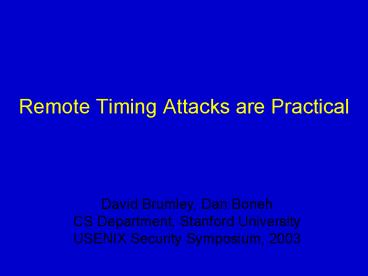Remote Timing Attacks are Practical - PowerPoint PPT Presentation
1 / 19
Title:
Remote Timing Attacks are Practical
Description:
Attacks 1 and 2 require special equipment and physical access to the machine. ... How to compute gd mod q for some g,d, and q. Square and multiply; ... – PowerPoint PPT presentation
Number of Views:59
Avg rating:3.0/5.0
Title: Remote Timing Attacks are Practical
1
Remote Timing Attacks are Practical
David Brumley, Dan Boneh CS Department, Stanford
University USENIX Security Symposium, 2003
2
Introduction
- Side-channel attacks
- Power analysis
- Electromagnetic radiation
- Timing attacks analyze the dependency of
response time on input to discover private
information. - Attacks 1 and 2 require special equipment and
physical access to the machine.
3
Scope of Timing Attacks
- Timing attacks were used to hack smartcards and
other simple devices. They are difficult to use
in a complex environment. - This paper shows a way to attack OpenSSL in
various environments - Network 2 machines connected through 3 routers
and a number of switches - Interprocess
- Virtual Machines
4
OpenSSLs Implementation of RSA
- Decryption mcd mod N where d is private key, c
is ciphertext, Npq. - Use CRT to compute this m1cd1 mod p and m2cd2
mod q, then combine m1 and m2. - Goal of attack get d. Can be done if we know p
and q. Therefore, we are looking for a
factorization of N.
5
Exponentiation
- How to compute gd mod q for some g,d, and q.
- Square and multiply
- Sliding windows process a number of bits of d
per iteration. Requires some precomputing. - Key fact about exponentiation the number of
times when a multiplication by g occurs depends
on the bits of q. - Timing attack on sliding windows is much harder
than that on square and multiply.
6
Montgomery Reduction
- Computing xy mod q is done by first multiplying x
and y and then reducing the result modulo q. - Naïve method divide and take remainder.
- Montgomery reduction more sophisticated. Key
fact sometimes it requires and extra reduction.
Prextra reduction(g mod q)/2R.
7
Multiplication Routines
- Karatsuba takes O(n1.58), used to multiply two
numbers of equal number of words. - Normal takes O(nm), used to multiply numbers
with an unequal number of words.
8
Comparison of Timing Differences
- Two sources of timing differences extra
reduction in a Montgomery reduction and choice of
multiplication routine. Unfortunately, they
compensate each other. - As g approaches a multiple of q from below, the
number of extra reduction increases and
dramatically drops once ggtq. - When g is almost as big as q, Karatsuba is used
mostly. But when g becomes greater than q, g mod
q is very small and normal algorithm is used
mostly.
9
A Timing Attack on OpenSSL (1/2)
- Basic idea make initial guess and refine it by
learning bits one at a time, from most
significant. - Initialization make initial guess g of q lying
between 2512 and 2511. Then try all possible
combinations of the top few bits. We will get two
picks one for p, another for q. Pick the first
peak.
10
A Timing Attack on OpenSSL (2/2)
- Suppose we have recovered i-1 bits of q. Let us
set all remaining bits of g to 0. We recover ith
bit of q as follows - ghi same as g with ith bit set to 1. If ith
bit of q is 1 then gltghiltq, else gltqltghi. - uggR-1 mod N, ughighiR-1 mod N
- Measure t1DecrtyptTime(ug), t2DecryptTime(ughi).
- Dt1-t2. If D is large then gltqltghi and ith
bit of q is 1, otherwise the bit is 0. - When D is large, it can be either positive or
negative, depending on whether Montgomery
reduction or multiplication dominates.
11
Exponentiation Revisited
- We want tg1-tg2gtgttg3-tg4 when g1ltqltg2 and
g3ltg4ltq. Multiplication by sliding windows makes
the difference subtle. - Solution query a neighborhood of values g, g1,
g2. and take sum of the times.
12
Real-world Scenarios
- We discuss an attack on SSL applications such as
stunnel and an Apache web server with mod_SSL. - During the handshake, SSL server performs RSA
decryption of CLIENT-KEY-EXCHANGE message (sent
by client) using its private key. We want to get
this key. - After decryption, the server checks PKCS 1 padded
random bytes and sends an error message back to
client in case of an error. The client can send
another message to the server that will be
decrypted there.
13
Experiments (1/5)
- Test the effects on increasing the number of
decryption requests required to recover a single
bit of q reliably. Two parameters neighborhood
size (n) and sample size (s). Total number of
queries is sn.
- We used sample size of 7 and neighborhood of 400,
1433600 total queries. Attack time is about 2
hours.
14
Experiments (2/5)
- Architecture effects compare two versions of a
program making local calls to OpenSSL regular
and extra-inst with 6 additional nops before
decryption.
- Explanation different cache hit rate 0.139 of
load misses for normal and 0.151 for
extra-inst.
15
Experiments (3/5)
- Compile-time effects
- Optimized (-O3 fomit_frame_pointer
mcpupentium) - No Pentium flag (-O3 fomit_frame_pointer)
- Unoptimized (-g).
16
Experiments (4/5)
- Source-based optimizations implemented a minor
patch that improves the efficiency of of CRT
decryption check.
17
Experiments (5/5)
- Attacking SSL applications on the local network
18
Defenses (1/2)
- Blinding before decryption compute xreg mod N,
where r is random. Then decrypt x, then compute
x/r. Incurs 2-10 penalty.
19
Defenses (2/2)
- Make all RSA decryptions not dependent upon the
input ciphertext. Use one multiplication routine
and always carry out extra reduction in
Montgomerys algorithm. - Require all RSA computations to be quantized.
Matt Blazes quantize library is an example of
this approach. - Currently preferred method blinding.































